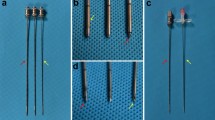Abstract
Background
The kidney is one of the most frequently injured intraabdominal organs. In this study, we investigated the efficacy and safety of radiofrequency ablation (RFA) as a kidney-preserving hemostatic technique for grade IV renal trauma.
Methods
A grade IV injury was induced in the right kidney of 12 Landrace pigs. Then RFA was applied around the injury in 10 animals until hemostasis was achieved; two animals were not treated (control group). The treated animals were killed humanely on days 0, 3, 7, 14 and 21 and examined. The kidneys were subjected to histologic and radiologic examination.
Results
The two untreated animals died from hypovolemic shock. Hemostasis was achieved in all treated animals. We had no operative deaths and no morbidity. No blood, pus, urine, or other fluid was found at the time of death. In one animal, a fistulous lesion leading to the collecting system was identified, but no urine leakage was observed. At histology, the ablated areas were found to consist of three zones: an inner necrotic one, a zone of neutrophils digesting necrotic tissue, and an outer zone with possibly reversible damage.
Conclusions
Radiofrequency ablation is an efficient and safe hemostatic method for grade IV renal trauma. Further study is needed to investigate the possible application of this method to humans and its percutaneous or laparoscopic use.


Similar content being viewed by others
References
WC Collyer J Landman EO Olweny C Andreoni K Kerbl DG Bostwick RV Clayman (2001) ArticleTitleComparison of renal ablation with cryotherapy, dry radiofrequency and saline augmented radiofrequency in a porcine model J Am Coll Surg 193 505–513 Occurrence Handle1:STN:280:DC%2BD3MnmtlamsA%3D%3D Occurrence Handle11708507
AL Denys T Baere ParticleDe C Mahe JC Sabourin A Sa Cunha S Germain A Roche (2001) ArticleTitleRadio-frequency tissue ablation of the liver: effects of vascular occlusion on lesion diameter and biliary and portal damages in a pig model Eur Radiol 11 2102–2108 Occurrence Handle1:STN:280:DC%2BD3MnkvVaktQ%3D%3D Occurrence Handle11702147
IS Gill TH Hsu RL Fox A Matamoros CD Miller RF LeVeen MT Grune et al. (2000) ArticleTitleLaparoscopic and percutaneous radiofrequency ablation of the kidney: acute and chronic porcine study Urology 56 197–200 Occurrence Handle1:STN:280:DC%2BD3czpsVaksg%3D%3D Occurrence Handle10925077
SN Goldberg GS Gazelle L Solbiati WJ Rittman PR Mueller (1996) ArticleTitleRadiofrequency tissue ablation: increased lesion diameter with a perfusion electrode Acad Radiol 3 636–644 Occurrence Handle1:STN:280:BymA1cbktlQ%3D Occurrence Handle8796727
CC Hammer RA Santucci (2003) ArticleTitleEffect of an institutional policy of nonoperative treatment of grade I to IV renal injuries J Urol 169 1751–1753 Occurrence Handle12686825
TH Hsu ME Fidler IS Gill (2000) ArticleTitleRadiofrequency ablation of the kidney: acute and chronic histology in porcine model Urology 56 872–875 Occurrence Handle1:STN:280:DC%2BD3crhtlWqtg%3D%3D Occurrence Handle11068326
RY Kim JL Weintraub J Susman ZJ Haskal (2002) ArticleTitleRadiofrequency ablation for hemobilia secondary to hepatocellular carcinoma J Vasc Interv Radiol 13 317–320 Occurrence Handle11875092
RL Kuo SR Eachempati MJ Makhuli RL Reed SuffixII (2002) ArticleTitleFactors affecting management and outcome in blunt renal injury World J Surg 26 416–419 Occurrence Handle11910472
PF Laeseke TC Winter Suffix3rd CL Davis KR Stevens CD Johnson FJ Fronczak JG Webster et al. (2003) ArticleTitlePostbiopsy bleeding in a porcine model: reduction with radio-frequency ablation — preliminary results Radiology 227 493–499 Occurrence Handle12676970
JA Margenthaler TR Weber MS Keller (2002) ArticleTitleBlunt renal trauma in children: experience with conservative management at a pediatric trauma center J Trauma 52 928–932 Occurrence Handle11988661
Y Miao Y Ni H Bosmans J Yu J Vaninbroukx S Dymarkowski H Zhang et al. (2001) ArticleTitleRadiofrequency ablation for eradication of renal tumor in a rabbit model by using a cooled-tip electrode technique Ann Surg Oncol 8 651–657 Occurrence Handle1:STN:280:DC%2BD3MritFeiug%3D%3D Occurrence Handle11569780
E Moore S Shackford H Packter J McAninch B Browner H Champion L Flint et al. (1989) ArticleTitleOrgan injury scaling: spleen, liver and kidney J Trauma 29 1664–1666 Occurrence Handle1:STN:280:By%2BD1c%2FgsVE%3D Occurrence Handle2593197
AJ Nicol D Theunissen (2002) ArticleTitleRenal salvage in penetrating renal injuries: a prospective analysis J Trauma 53 351–353 Occurrence Handle12169946
RS Russell A Gomelsky DR McMahon D Andrews PF Nasrallah (2001) ArticleTitleManagement of grade IV renal injury in children J Urol 166 1049–1050 Occurrence Handle1:STN:280:DC%2BD3Mvktl2qsA%3D%3D Occurrence Handle11490296
RA Santucci JM McAninch (2001) ArticleTitleGrade IV renal injuries: evaluation, treatment and outcome World J Surg 25 1565–1572 Occurrence Handle1:STN:280:DC%2BD38%2FkvVWitA%3D%3D Occurrence Handle11775193
RL Titton DA Gervais GW Boland PR Mueller (2002) ArticleTitleRenal trauma: radiologic evaluation and percutaneous treatment of nonvascular injuries AJR 178 1507–1511 Occurrence Handle12034629
KG Toutouzas M Karaiskakis A Kaminski GC Velmahos (2002) ArticleTitleNonoperative management of blunt renal trauma: a prospective study Am Surg 68 1097–1103 Occurrence Handle12516817
JC Weber G Navarra LR Jiao JP Nicholls SL Jensen NA Habib (2002) ArticleTitleNew technique for liver resection using heat coagulative necrosis Ann Surg 236 560–563 Occurrence Handle12409660
JC Weber G Navarra NA Habib P Bachellier D Jaeck (2003) ArticleTitleLaparoscopic radiofrequency-assisted liver resection Surg Endosc 17 834 Occurrence Handle1:STN:280:DC%2BD2M7jsVWjuw%3D%3D
H Wessells D Suh JR Porter F Rivara EJ MacKenzie GJ Jurkovich AB Nathens (2003) ArticleTitleRenal injury and operative management in the United States: results of a population-based study J Trauma 54 423–430 Occurrence Handle12634519
Author information
Authors and Affiliations
Corresponding author
Rights and permissions
About this article
Cite this article
Kontos, M., Felekouras, E., Drakos, E. et al. Radiofrequency tissue ablation in an experimental model of grade IV renal trauma: a preliminary report. Surg Endosc 19, 249–253 (2005). https://doi.org/10.1007/s00464-003-9327-y
Received:
Accepted:
Published:
Issue Date:
DOI: https://doi.org/10.1007/s00464-003-9327-y




